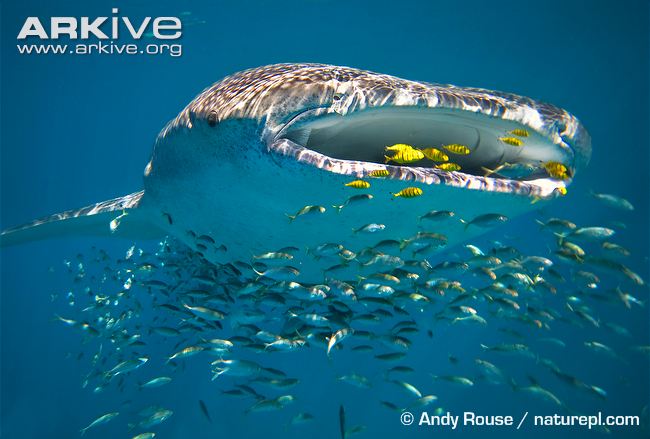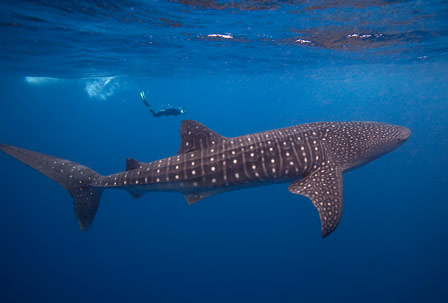 r body.
Whale sharks measure up to 20 external m long and weigh up to 34,000 external kg. Most individuals encountered are between 6-12 external m long. Like most sharks, the females are larger than males.
r body.
Whale sharks measure up to 20 external m long and weigh up to 34,000 external kg. Most individuals encountered are between 6-12 external m long. Like most sharks, the females are larger than males. Home | Favorites | whale shark | MW3 | pics | BYU | Utes| Men at Work |Eagles
Whale sharks, Rhincodon typus (Smith, 1828), are the biggest sharks and the biggest fishes in the ocean. They are NOT whales nor arethey dangerous to humans (like nearly all sharks). They have a distinctively wide mouth at the very front of their head (rather than on the underside like most sharks). They have wide, flat heads, rounded snouts, small eyes, 5 very large gill slits, 2dorsal fins and 2 pectoral fins. The spiracle (a vestigial first gill slit used for breathing when the shark is resting on the sea floor) is located just behind the shark's eye. Its tail has a top fin only slightly larger than the lower fin.
Whale sharks have distinctive light-yellow or white markings (random stripes and dots) on their very thick dark gray skin which is up to 10 external cm thick. They also have threeprominent ridges running along each side of thei r body.
Whale sharks measure up to 20 external m long and weigh up to 34,000 external kg. Most individuals encountered are between 6-12 external m long. Like most sharks, the females are larger than males.
r body.
Whale sharks measure up to 20 external m long and weigh up to 34,000 external kg. Most individuals encountered are between 6-12 external m long. Like most sharks, the females are larger than males.
Whale sharks have a very widespread distribution, occurring in all tropical and warm temperate seas, except in the Mediterranean. During the day, they spend most of their time feeding near the surface, preferring sea surface temperatures around 21-30 external°C, they often go deep at night and when traveling, reaching depths of more than 700 external m.
Whale sharks are filter feeders, sieving enormous  amounts of plankton, krill, small fish and even squid through their gills as they swim along. After closing their mouth, the sharks use their gills rakers external, thousands of bristly structures about 10 external cm long, to clean the captured prey from its gills. Anything that doesn't pass through the gills is eaten. Whale sharks sometimes assume a vertical orientation in the water, rhythmically rising partially above the surface and sinking below with mouth wide open, allowing plankton-bearing water to flush through the gill rakers. Whale sharks can filter over 6,000 external liters of water an hour and have about 27,000 very tiny teeth arranged in some 300 rows but they are of little use in feeding.
amounts of plankton, krill, small fish and even squid through their gills as they swim along. After closing their mouth, the sharks use their gills rakers external, thousands of bristly structures about 10 external cm long, to clean the captured prey from its gills. Anything that doesn't pass through the gills is eaten. Whale sharks sometimes assume a vertical orientation in the water, rhythmically rising partially above the surface and sinking below with mouth wide open, allowing plankton-bearing water to flush through the gill rakers. Whale sharks can filter over 6,000 external liters of water an hour and have about 27,000 very tiny teeth arranged in some 300 rows but they are of little use in feeding.
source: marinebio.org/oceans/creatures.asp